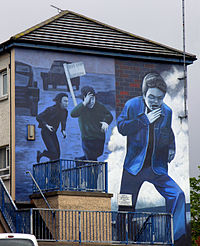- CS gas
-
CS gas 
 2-ChlorobenzalmalononitrileOther namesTear gas
2-ChlorobenzalmalononitrileOther namesTear gasIdentifiers CAS number 2698-41-1 
ChemSpider 16644 
Jmol-3D images Image 1 - Clc1ccccc1\C=C(/C#N)C#N
Properties Molecular formula C10H5Cl N2[2] Molar mass 188.6 g/mol[1] Appearance White crystalline powder
Colourless gas when burnedDensity 1.04 g/cm3 Melting point 93°C, (366.15 K), (199.4 °F)
Boiling point 310 °C, (583.15 K), (590 °F)[3]
Vapor pressure (mm Hg) 3.4 × 10−5 at 20 °C Hazards MSDS External MSDS NFPA 704 Related compounds Related compounds SDBS Supplementary data page Structure and
propertiesn, εr, etc. Thermodynamic
dataPhase behaviour
Solid, liquid, gasSpectral data UV, IR, NMR, MS  gas (verify) (what is:
gas (verify) (what is:  /
/ ?)
?)
Except where noted otherwise, data are given for materials in their standard state (at 25 °C, 100 kPa)Infobox references 2-chlorobenzalmalononitrile (also called o-chlorobenzylidene malononitrile) (chemical formula: C10H5ClN2) is the defining component of a "tear gas" commonly referred to as CS gas, which is used as a riot control agent. "CS gas" is actually an aerosol of a volatile solvent (a substance that dissolves other active substances and that easily evaporates with it) and 2-chlorobenzalmalononitrile, which is a solid compound at room temperature. CS gas is generally accepted as being non-lethal. It was discovered by two Americans, Ben Corson and Roger Stoughton, at Middlebury College in 1928, and the chemical's name is derived from the first letters of the scientists' surnames.[4][5]
CS was developed and tested secretly at Porton Down in Wiltshire, England, in the 1950s and 1960s. CS was used first on animals, then subsequently on British Army servicemen volunteers. Notably, CS has a limited effect on animals due to "under-developed tear-ducts and protection by fur".[6]
Contents
Production
CS is synthesized by the reaction of 2-chlorobenzaldehyde and malononitrile via the Knoevenagel condensation:
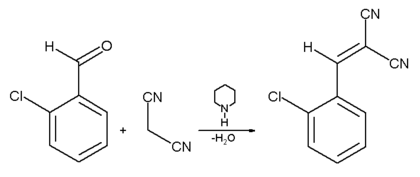
-
- ClC6H4CHO + H2C(CN)2 → ClC6H4CHC(CN)2 + H2O
The reaction is catalysed with weak base like piperidine or pyridine. The production method has not changed since the substance was discovered by Corson and Stoughton.[7] Other bases, solvent free methods and microwave promotion have been suggested to improve the production of the substance.[8]
The physiological properties had been discovered already by the chemists first synthesising the compound in 1928: "Physiological Properties. Certain of these dinitriles have the effect of sneeze and tear gases. They are harmless when wet but to handle the dry powder is disastrous. (sic)"[7]
Use as an aerosol
As 2-chlorobenzalmalononitrile is a solid at room temperature, not a gas, a variety of techniques have been used to make this solid usable as an aerosol:
- Melted and sprayed in the molten form.
- Dissolved in organic solvent.
- CS2 dry powder (CS2 is a siliconized, micro-pulverized form of CS).
- CS from thermal grenades by generation of hot gases.[1]
In the Waco Siege, CS was dissolved in the organic solvent dichloromethane (also known as methylene chloride). The solution was dispersed as an aerosol via explosive force and when the highly volatile dichloromethane evaporated, CS crystals precipitated and formed a fine dispersion in the air.[1]
Effects
Many types of tear gas and other riot control agents have been produced with effects ranging from mild tearing of the eyes to immediate vomiting and prostration. CN and CS are the most widely used and known, but around 15 different types of tear gas have been developed worldwide e.g. adamsite or bromoacetone, CNB, and CNC. CS has become the most popular due to its strong effect and lack of toxicity in comparison with other similar chemical agents. The effect of CS on a person will depend on whether it is packaged as a solution or used as an aerosol. The size of solution droplets and the size of the CS particulates after evaporation are factors determining its effect on the human body.[9]
The chemical reacts with moisture on the skin and in the eyes, causing a burning sensation and the immediate forceful and uncontrollable shutting of the eyes. Effects usually include tears streaming from the eyes, coughing, running nose full of mucus, burning in the nose and throat areas, disorientation, dizziness and restricted breathing. It will also burn the skin where sweaty and or sunburned. In highly concentrated doses it can also induce severe coughing and vomiting. Almost all of the immediate effects wear off in a matter of minutes.
Toxicity
Although described as a non-lethal weapon for crowd control, many studies have raised doubts about this classification. As well as creating severe pulmonary damage, CS can also significantly damage the heart and liver.[10]
On September 28, 2000, Prof. Dr. Uwe Heinrich released a study commissioned by John C. Danforth, of the United States Office of Special Counsel, to investigate the use of CS by the FBI at the Branch Davidians' Mount Carmel compound. He concluded that the lethality of CS used would have been determined mainly by two factors: whether gas masks were used and whether the occupants were trapped in a room. He suggests that if no gas masks were used and the occupants were trapped, then, "...there is a distinct possibility that this kind of CS exposure can significantly contribute to or even cause lethal effects."[1]
Many reports have associated CS exposure with miscarriages.[10] This is consistent with its reported clastogenic effect (abnormal chromosome change) on mammalian cells.
When CS is metabolized, cyanide can be detected in human tissue.[10] According to the United States Army Center for Health Promotion and Preventive Medicine, CS emits "very toxic fumes" when heated to decomposition, and at specified concentrations CS gas is an immediate danger to life and health. They also state that those exposed to CS gas should seek medical attention immediately.[2]
In Israel, CS gas was reported to be the cause of death of Jawaher Abu Rahmah on December 31, 2010,[11] although the Israel Defence Forces have questioned the veracity of the report.
It has been noted that the solvent MiBK is itself harmful, and can cause inflammation, dermatitis, burns to the skin and liver damage.[12]
Decontamination
CS contamination can be removed by washing with an alkaline solution of water and 5% sodium bisulfite.[6][13]
Use
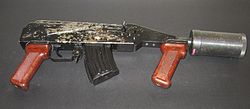 RWGŁ-3 Polish tear gas grenade launcher.
RWGŁ-3 Polish tear gas grenade launcher.
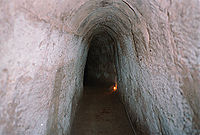 CS was used to flush the Viet Cong from their tunnels in Vietnam.
CS was used to flush the Viet Cong from their tunnels in Vietnam.
CS is used in spray form by many police forces as a temporary incapacitant and to subdue attackers or persons who are violently aggressive. Officers that are trained in the use and application of CS spray are routinely exposed to it as part of their training.
Recently, blank pistol cartridges carrying CS in powder form have been released to public. These, when fired in relatively close ranges, fully expose the target to the effects of CS, and are employed as a potent defensive weapon in regions where blank firing pistols are legally permitted for such use.
Although predominantly used by police it has also been used in criminal attacks in various countries.[14][15][16][17]
Use of CS in war is prohibited under the terms of the 1997 Chemical Weapons Convention, signed by most nations in 1993 with all but five other nations signing between the years of 1994 through 1997. The reasoning behind the prohibition is pragmatic: use of CS by one combatant could easily trigger retaliation with much more toxic chemical weapons such as nerve agents. Only five nations have not signed the Chemical Weapons Convention and are therefore unhindered by restrictions on the use of CS gas: Angola, Egypt, North Korea, Somalia, and Syria.[18]
Domestic police use of CS is legal in many countries, however, as the Chemical Weapons Convention prohibits only military use.
Cyprus
CS was first tested in the field by the British army in Cyprus in 1958. At this time it was known by the code name T792.[19]
Iraq
Iraq successfully developed CS during the 1970s and during the 1980s produced tons of the substance firstly at Salman Pak and later at al-Muthanna.[20] Then-Iraqi leader Saddam Hussein ordered troops to use nerve agents against Iraqi Kurds in his own country and against Iran during the Iran–Iraq War. It is believed that Iraqi forces used multiple chemical agents during the attack, including mustard gas and the nerve agents sarin, soman, tabun and VX;[21] some sources have also pointed to the blood agent hydrogen cyanide.
Main article: Halabja poison gas attackBlackwater Worldwide, acting as an agent of the United States, deployed CS in the Iraq War from a helicopter hovering over a checkpoint in the Green Zone in Bagdhad.[22]
Israel
Israel Police forces spray CS gas at riot control situations. It is widely used at demonstrations within the Palestinian Territories and at the Israeli West Bank barrier as a non-lethal weapon.[23][24]
Philippines
CS tear gas was used in suppression of the mutiny in Makati that was led by Sen. Antonio Trillanes. The tear gas was fired in the building and all the people in the building including reporters were affected.
Sri Lanka
The LTTE, also known as Tamil Tigers of Sri Lanka, an insurgent group in Sri Lanka used CS gas against government forces that were on an offensive to flush and defeat these insurgents during September 2008.[25] Its use hindered the army's progress but ultimately proved ineffective in preventing the army from overrunning LTTE positions.
This is one of the first few cases of insurgents using CS gas as an insurgent weapon.
United Kingdom
Northern Ireland
 A mural in Derry, Northern Ireland of a young boy in a gas mask holding a petrol bomb during the Battle of the Bogside, August 1969.
A mural in Derry, Northern Ireland of a young boy in a gas mask holding a petrol bomb during the Battle of the Bogside, August 1969.
CS gas was used extensively in the Bogside area of Derry, Northern Ireland during the "Battle of the Bogside", a two-day riot in August, 1969. A total of 1,091 canisters containing 12.5g of CS each, and 14 canisters containing 50g of CS each, were released in the densely populated residential area.[26] On 30 August the Himsworth Inquiry was set up to investigate the medical effects of its use in Derry. Its conclusions, viewed in the political context of the time, still pointed towards the necessity of further testing of CS gas before being used as a riot control agent. During the rioting in Belfast, the following year, known as the Falls Curfew, the Army fired up to 1,600 canisters into the densely populated Falls Road area. It was also used in Lenadoon on 9 July 1972 on the breakdown of the IRA ceasefire. Not long after, the British Army and RUC ceased using CS in Northern Ireland. Up to this point, it had been used in crowd control scenarios in Derry and Belfast.
Great Britain
The first use of CS gas on the UK mainland, which was not part of military training, was carried out in 1944 during a hostage siege at a North London address. Soldiers were asked to throw CS grenades through the skylight in hope of bringing the incident to a speedy conclusion, however, the hostage-taker had brought his civilian-issue gas mask with him, negating the effect.[citation needed]
The siege of Trough Gate, in Oldham, during 1973 was the second use of CS gas on UK Mainland. It was applied to the rear of a van where the chief suspect was hiding. The suspect committed suicide with the handgun he was armed with.
The first use of CS tear gas to quell rioting in mainland Britain was in the Toxteth area of Liverpool in 1981.[27]
CS gas incapacitant sprays were first introduced into the British police in 1995, to assist them in dealing with violent incidents.[28] The CS is in the form of a hand-held aerosol canister, with the solution being 5% CS, with methyl isobutyl ketone as the solvent, which is propelled by pressurized nitrogen. The liquid stream is directed where the user points the canister, being accurate up to 4 metres. All forces dictate that for an officer to be authorised to carry CS, they have to have completed a training course in the spray's use. Under UK firearm law CS and other incapacitant sprays are classed as prohibited weapons, making it unlawful for a member of the public to possess such an item. In recent years, some forces have stopped using CS, in favour of the new PAVA spray.[29]
A six month trial by sixteen police forces in England began on the 1 March 1996. Only two weeks later, on 16 March 1996, a Gambian asylum seeker, Ibrahima Sey was taken to Ilford Police Station in east London. Whilst incapacitating the man, police sprayed him with CS and held him on the ground for over 15 minutes, and he subsequently died. Although a verdict of unlawful killing was given by the jury at the end of the inquest into his death, no charges were brought against any member of the police force.[30]
The police forces that do use the PIS in the UK require that the personnel undergoing training should themselves be sprayed with a 3% dissolved CS, during self-defense training, in order for them to be able to be authorized to carry it as personal protection equipment. They are also trained in helping the incapacitated person recover quickly once successfully restrained. Most forces currently issue CS spray to its officers, but there has been a recent move for a few forces to issue PAVA Spray (pelargonic acid vanillylamide aka nonivamide).
The CS spray used by UK police is five times more concentrated than the spray used by American police forces (5% dissolved CS and 1% CS respectively).[31]
In 1999 the UK mental health charity MIND called for a suspension in its use until it is fully tested and there is proof that CS is safe.[32]
In February 2006, there were calls to have CS spray banned in the UK after Dan Ford, from Wareham in Dorset, was permanently facially scarred after being sprayed in the face with a police CS canister. Mr Ford was subsequently advised by doctors to stay out of sunlight for at least 12 months. After the incident, his cousin, Donna Lewis, was quoted as saying, "To look at him, it was like looking at a melting man, with liquid oozing from his face."[33] However, it has not yet been confirmed that Mr Ford's injury was a reaction to having been exposed to police CS spray, or whether an unrelated chemical exposure caused the injury. An investigation is ongoing.
In January 2011, CS was used by the Metropolitan Police at a UK Uncut protest in London.[34][35]
The British Armed Forces use CS gas annually to test their CBRN equipment. During initial training they introduce recruits to CS gas by ordering them into a small enclosed space known as a Respirator Test Facility (RTF) and igniting chemical tablets to induce CS production. After recruits have carried out their CBRN drills, they must remove their respirators and inhale the CS to realise it effects and become confident their masks work.[not in citation given] [36][37]
United States
CS is used by many police forces within the United States. It was most famously used as one of a number of techniques by Federal Bureau of Investigation law enforcement officials in the 1993 Waco Siege.[38]
Riot police in Pittsburgh, Pennsylvania in September, 2009 used CS gas and riot control techniques to disperse assemblies in the vicinity of the 2009 G-20 Pittsburgh summit.
In Berkeley, California during the Bloody Thursday events in People's Park on Wednesday, May 21, 1969, a midday memorial was held for student James Rector, a non-protester shot to death by police, at Sproul Plaza on the University campus. In his honor, several thousand people peacefully assembled to listen to speakers remembering his life. Without warning, National Guard troops surrounded Sproul Plaza, donned their gas masks, and pointed their bayonets inward, while helicopters dropped CS gas directly on the trapped crowd. No escape was possible, and the gas caused acute respiratory distress, disorientation, temporary blindness and vomiting. Many people, including children and the elderly, were injured during the ensuing panic. The gas was so intense that breezes carried it into Cowell Memorial Hospital, endangering patients, interrupting operations and incapacitating nurses. Students at nearby Jefferson and Franklin elementary schools were also affected.[39][40]
Members of the United States armed forces are exposed to CS during initial training, and during training refresher courses or equipment maintenance exercises, using CS tablets that are melted on a hotplate. This is to demonstrate the importance of properly wearing a gas or protective mask, as the agent's presence quickly reveals an improper fit or seal of the mask's rubber gaskets against the face. Following exposure while wearing a mask, recruits are ordered to remove the masks and endure exposure in the room for one minute. These exercises also encourage confidence in the ability of the equipment to protect the wearer from such chemical attacks. Such an event is a requirement for graduation from United States Army Basic Training, Air Force Basic Military Training, Navy Basic Training, and Marine Corps recruit training.[41] CS gas in the form of grenades is also used extensively in the United States Marine Corps in some service schools. CS gas is used during the final field exercise of the Scout Sniper Basic Course to simulate being compromised. In addition, it is used during the 25 km (16 mi) escape-and-evasion exercise ("Trail of Tears"), the last event before graduation from the course. It is also used during several events in the Marine Corps Basic Reconnaissance Course (BRC) including some rucksack runs and escape-and-evasion exercises. While students going through the course are given the opportunity to bring and wear a gas mask for the event, usually none are worn because once donned, gas masks could not be removed until the end of the exercise. This could last anywhere from 3–12 hours and would make running 25 km while wearing 125 lb (57 kg) of gear virtually impossible.
Vietnam
It has been reported that thousands of tons of CS gas were used by the U.S. forces in Vietnam to bring Viet Cong into the open. It was also used by the North Vietnamese forces in some battles like Hue in 1968 or during the Easter Offensive in 1972.[42]
Elsewhere
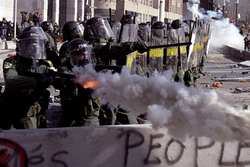 Police fire tear gas at protesters in Quebec.
Police fire tear gas at protesters in Quebec.
CS gas has been and is still routinely used by Greek riot police (MAT) in order to quell student and labor protests, as well as riots by hooligans. In some cases gas had expired for more than thirty years. The legality and safety of the use of CS by policemen has been challenged both by people within Greece and the European Union.[citation needed]
CS was used to quell a protest in Lusaka, Zambia in July 1997 and the 1999 WTO riots in Seattle. Amnesty International reported that it had been manufactured by the UK company Pains-Wessex. Subsequently, Amnesty called for an export ban when the receiving regime is either not fully trained in the use of CS, or had shown usage "contrary to the manufacturer’s instructions".[43]
In September 2000, the Guardian newspaper revealed how a UK company, HPP, used legal loopholes to export CS to a private security company in Rwanda, in breach of United Nations sanctions.[44] The Guardian also reported that CS was used by the Hutu militia in Rwanda to flush Tutsis out of buildings before hacking them to death.
CS has been used by the government in South Africa; by Israel against Palestinians and Israelis; by the South Korean government in Seoul, and during the Balkan conflicts by Serbia. In Malta it was used by Police between 1981 and 1987 to the detriment of Nationalist Party Supporters.
CS tear gas was used at the G8 protests in Genoa, Italy[45] and Quebec City, Canada[46] during the FTAA anti-globalization demonstrations during the Quebec City Summit of the Americas.
The Canadian, Norwegian and Australian Armies train their soldiers with CS gas in a manner similar to that of the USA, as it is a basic part of CBRN (Chemical, Biological, Radiological, Nuclear) training. Gas is released by burning tablets, usually in a building reserved for this purpose (a "gas hut"). In the training, the person enters the building unprotected, and must fit and clear the gas mask before leaving. Other drills such as drinking and under-mask decontamination are also practiced. Some Norwegian units are exposed to CS-gas while engaged in physical activity such as push-ups.
See also
References
- ^ a b c d Heinrich, U. "Possible lethal effects of CS tear gas on Branch Davidians during the FBI raid on the Mount Carmel compound near Waco, Texas." www.veritagiustizia.it.] September 2000. Retrieved on September 23, 2007
- ^ a b Williams, Kenneth E. "Detailed Facts About Tear Agent O-Chlorobenzylidene Malononitrile (CS)." U.S. Army Center for Health Promotion and Preventive Medicine. Retrieved on September 23, 2007. Archived September 26, 2007 at the Wayback Machine
- ^ Hoenig, Steven L. (2006). Compendium of Chemical Warfare Agents. Springer. p. 138. ISBN 0387346260. http://books.google.com/?id=y2FwGRVMW5kC&pg=PA138.
- ^ "CS". Oxford English Dictionary. Oxford University Press. 2nd ed. 1989.
- ^ "CS, chemical compound." columbia.thefreedictionary.com. Retrieved on September 23, 2007
- ^ a b "Orthochlorobenzylidenemalononitrile ClC6H4CHCCN(CN)2." Zarc International. Retrieved on September 23, 2007
- ^ a b Corson BB, Stoughton RW (1928). "Reactions of Alpha, Betha-Unsaturated Dinitriles". J Am Chem Soc 50 (10): 2825–2837. doi:10.1021/ja01397a037.
- ^ Pande A, Ganesan K, Jain AK, Gupta PK, Malhotr RC (2005). "Novel Eco-Friendly Process for the Synthesis of 2-Chlorobenzylidenemalononitrile and ITS Analogues Using Water As a Solvent". Org Proc Res Develop 9 (2): 133–136. doi:10.1021/op0498262.
- ^ "Safer Restraint: A report of the conference held in April 2002 at Church House, Westminster." Police Complaints Authority. Retrieved on September 23, 2007
- ^ a b c Hu, Howard et al. (1989). "The Use of Chemical Weapons: Conducting an Investigation Using Survey Epidemiology". Journal of the American Medical Association 262 (5): 640–3. doi:10.1001/jama.262.5.640. PMID 2746816. http://jama.ama-assn.org/content/262/5/640.abstract.
- ^ "Bil'in protester dies after exposure to tear gas shot by IDF". Haaretz. December 31, 2010. http://www.haaretz.com/news/diplomacy-defense/bil-in-protester-dies-after-exposure-to-tear-gas-shot-by-idf-1.334627.
- ^ "Safety data for methyl isobutyl ketone." Material Safety Data Sheet hosted by The Physical and Theoretical Chemistry Laboratory Oxford University. Last Updated on June 16, 2005. Retrieved on September 23, 2007. Archived September 25, 2007 at the Wayback Machine
- ^ Bhattacharya, S. T.; Hayward, AW (1993). "CS gas?implications for the anaesthetist". Anaesthesia 48 (10): 896. doi:10.1111/j.1365-2044.1993.tb07424.x. PMID 8238834.
- ^ Kelso, Paul. "CS gas attack by former pupil injures 68 children." The Guardian. October 1, 1999. Retrieved on September 23, 2007
- ^ Condon, Deborah. "Gas attack at Dublin hospital." www.irishhealth.com. May 14, 2004. Retrieved on September 23, 2007
- ^ "Shopkeeper attacked with CS gas." BBC News. December 1, 2005. Retrieved on September 23, 2007
- ^ "Car thieves spray gas at motorist." BBC News. January 4, 2006. Retrieved on September 23, 2007
- ^ United Nations Treaty Collection. Convention on the Prohibition of the Development, Production, Stockpiling and Use of Chemical Weapons and on their Destruction. Retrieved 19 January 2009.
- ^ "Final Report of the Expert Panel to Review SAS Veterans’ Health Concerns (Appendix D)." Retrieved on September 23, 2007
- ^ "WMD Profiles: Chemical." Iraq Watch. Retrieved on September 23, 2007
- ^ Death Clouds: Saddam Hussein’s Chemical War Against the Kurds 5/1/1991 | Dlawer dot Net. Dlawer.net. Retrieved on 2011-02-02.
- ^ Risen, James (January 10, 2008). "2005 Use of Gas by Blackwater Leaves Questions". The New York Times. http://www.nytimes.com/2008/01/10/world/middleeast/10blackwater.html. Retrieved 2009-08-08.
- ^ "Four Palestinians faint after inhaling CS gas". August 8, 2009. http://www.israel-palestinenews.org/2009/08/four-palestinians-faint-after-inhaling.html.
- ^ "Dozens hit by CS gas during anti-wall demonstrations". August 22, 2009. http://www.maannews.net/eng/ViewDetails.aspx?ID=220682.
- ^ "LTTE used CS Gas to attack Soldiers". Lanka Daily News. September 18, 2008. http://lankadailynews.com/2008/09/ltte-cs-gas-attack-soldiers/. Retrieved 2011-01-04.
- ^ Dr Raymond McClean (1997). The Road To Bloody Sunday (revised edition). Guildhall: Printing Press. ISBN 0-946451-37-0. (extracts available online)
- ^ "1965: British police to be issued with tear gas." BBC News. Retrieved on September 23, 2007
- ^ Euripidou E, MacLehose R, Fletcher A (2004). "An investigation into the short term and medium term health impacts of personal incapacitant sprays. A follow up of patients reported to the National Poisons Information Service (London)". Emerg Med J 21 (5): 548–52. doi:10.1136/emj.2003.012773. PMC 1726417. PMID 15333526. http://www.pubmedcentral.nih.gov/articlerender.fcgi?tool=pmcentrez&artid=1726417.
- ^ "INCAPACITANT SPRAY: Guidance on the Use of Incapacitant Spray". Association of Chief Police Officer of England, Wales & Northern Ireland. May 2009. http://www.acpo.police.uk/policies.asp.
- ^ "Report on the death in police custody of Ibrahima Sey." Inquest. 1997
- ^ Southward RD (2000). "CS incapacitant spray". J Accid Emerg Med 17 (1): 76. PMC 1756282. PMID 10659007. http://emj.bmjjournals.com/cgi/content/full/17/1/76-a.
- ^ "Experts fear unknown CS spray risks." BBC News. September 24, 1999. Retrieved on September 23, 2007
- ^ "CS spray man 'scarred for life'." BBC News. February 2, 2006. Retrieved on September 23, 2007
- ^ Video appears to show police using CS spray on tax protester | UK news | guardian.co.uk. Guardian. Retrieved on 2011-02-02.
- ^ BBC News – CS spray used on UK Uncut protest. Bbc.co.uk. Retrieved on 2011-02-02.
- ^ The Ohio National Guard Website. Ong.ohio.gov. Retrieved on 2011-02-02.
- ^ 7th Infantry Regiment Association | Cottonbalers | ODS | TF 2–7 Sep 08. Cottonbalers. Retrieved on 2011-02-02.
- ^ "A Primer on CS Gas." Public Broadcasting Service. 1995. Retrieved on September 23, 2007
- ^ Nation: Occupied Berkeley. TIME (1969-05-30). Retrieved on 2011-02-02.
- ^ The Sixties and Seventies from Berkeley to Woodstock. Fsmitha.com. Retrieved on 2011-02-02.
- ^ TRADOC Regulation 350-6 TRADOC 2007. Retrieved on October 13, 2008
- ^ Bryce, Robert. "Lethal Weapon: FBI's Use of Tear Gas Questioned at Davidian Trial." The Austin Chronicle. July 7, 2000. Retrieved on September 23, 2007
- ^ "Stopping the Torture Trade: 3 – Chemical Control."Amnesty International. Retrieved on September 23, 2007
- ^ Burke, Jason; Johnson-Thomas, Brian. "British firms trade in torture." The Guardian. September 10, 2000. Retrieved on September 23, 2007
- ^ Tartarini, Laura. "Genova Update." italy.indymedia.org. April 13, 2003. Retrieved on September 23, 2007
- ^ Di Matteo, Enzo. "Foggy Over Tear Gas Safety." NOW Online Edition. May 177–23, 2001. Retrieved on September 23, 2007
External links
- Gas Chromatography NIST
- U.S. Army Center for Health Promotion and Preventive Medicine General Facts About Tear Agent O-Chlorobenzylidene Malononitrile (CS) {pdf}
- Patten report recommendations 69 and 70 relating to public order equipment A Paper prepared by the Steering Group led by the Northern Ireland Office – April 2001
- Committees on toxicity, mutagenicity and carcinogenicity of chemicals in food, consumer products and the environment statement on 2-chlorobenzylidene malononitrile (CS) and CS spray, September 1999. (pdf)
- Journal of Non-lethal Combatives, January 2003 Noxious Tear-Gas Bomb Mightier in Peace than in War.
- "Crowd Control Technologies: An Assessment Of Crowd Control Technology Options For The European Union" – The Omega Foundation (pdf)
- Health and safety in policing University of Nottingham paper on CS use in the UK.
- Information and effects of CS and CN gas
- BBC 'wiki' site – entry on CS gas
- eMedicine Information on irritants: Cs, Cn, Cnc, Ca, Cr, Cnb, PS
- Carron P-N, Yersin B (2009). "Management of the effects of exposure to tear gas". BMJ 338 (7710): 1554–1558. doi:10.1136/bmj.b2283.
Blood Blister Ethyldichloroarsine (ED) · Methyldichloroarsine (MD) · Phenyldichloroarsine (PD) · Lewisite (L) · Sulfur mustard (HD · H · HT · HL · HQ) · Nitrogen mustard (HN1 · HN2 · HN3)
Nerve Pulmonary Incapacitating Riot control Categories:- Riot control agents
- Lachrymatory agents
- Chemical weapons
Wikimedia Foundation. 2010.


